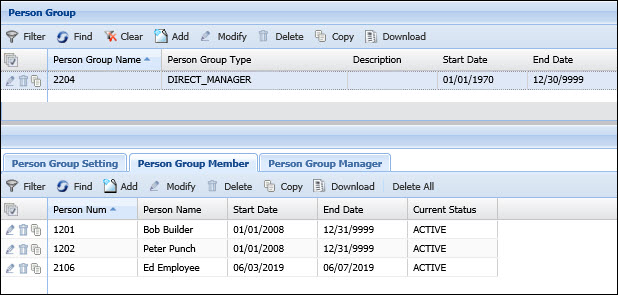
The Supervision Date Policy determines the dates when a supervisor can access the timecard records for the employees he manages. This policy affects the supervisor's ability to view, post, and sign timecards in the following forms:
Current Situation form and its timecard tabs (Period, Weekly, Daily, and Punch Time), including the Edit Schedule button
Time Card Review (web) and its timecard tabs
Time Card Review (mobile), including the Summary and Daily views
Period and Weekly timecards on the Authorized Hours form
Daily timecard in Labor Review form
You can configure the view, post, and sign functions separately in the policy.
For example, a Supervision Date Policy is configured to allow a supervisor to view an entire timecard, but only sign the timecard during the dates when he is managing the employee. A supervisor borrows an employee for three days (via an Employee Loan from another supervisor). The borrowing supervisor can view the entire period that includes the three-day loan, but can only sign the three days in the loan period.
This policy can be assigned to a single Employee/Person via the Employee Setting form, to an Employee Group with type POLICY_GROUP or FACILITY via the Employee Group Setting form, or to all users via the System Settings form. An Employee setting overrides an Employee Group setting, which overrides a System Setting. See Settings Precedence for more details.
If a supervisor is not assigned a Supervision Date Policy, the supervisor can view, sign, and post on any date in an employee's timecard as long as he accesses the timecard during one of the dates when he is managing the employee. This configuration is the same as setting VIEW, POST, and SIGN to "Today" in the Supervision Date Policy.
If you are Acting As a supervisor who delegated authority to you, the Supervision Date Policy of the delegating supervisor will take effect.
Note that the Supervision Date Policy does not affect the supervisor's use of the Self Service Timecard; it only affects the supervisor timecards for the employees he manages.
The Supervision Date Policy also does not affect any service instances that affect sign actions or event postings on the timecard (ATTENDANCE, RECALCULATON, etc.).
See Also:
VIEW Settings in the Supervision Date Policy
Viewing Employees in Current Situation
Viewing Employees in Time Card Review
POST Settings in the Supervision Date Policy
SIGN Settings in the Supervision Date Policy
The Supervision Date Policy will not take effect unless you enable a PVE Plugin called PROCESS_SUPERVISION_DATE.
Click Main Menu > Configuration > System > PVE Plugin.
Select the PROCESS_SUPERVISION_DATE option and click Modify.
Check the Enabled box and click Save.
Restart the application server.
The VIEW setting in the Supervision Date Policy determines the dates when a supervisor can view employee data and employee timecards. This setting also affects the supervisor's ability to use the Schedule Edit button in Current Situation.
The view options in Current Situation and Time Card Review are different for each form. Current Situation displays employees based on a single Posting Date. Time Card Review displays employees based on a date range. Refer to Viewing Employees in Current Situation and Viewing Employees in Time Card Review for more information.
The VIEW settings in the Supervision Date Policy are explained below.
The employees that appear in the Current Situation form will depend on the Posting Date you select and the VIEW setting in your Supervision Date Policy.
If VIEW is set to Today, the supervisor will only see employees that he manages on the date he is logged in, regardless of the Posting Date in the Current Situation filter.
If VIEW is set to Supervision Dates All Days or Supervision Dates Any Days, the supervisor will only see employees that he manages on the Posting Date in the Current Situation filter.
If VIEW is set to Either All Days or Either Any Days, the supervisor will see employees that he manages Today (the date he is logged in) or employees that he manages on the Posting Date in the Current Situation filter.
The employees that appear in the Time Card Review form will depend on the Date Range Type you select in the Time Card Review filter and the VIEW setting in your Supervision Date Policy.
If VIEW is set to Today, the supervisor will only see employees that he manages on the date he is logged in, regardless of the Date Range Type in the Time Card Review filter.
If VIEW is set to Supervision Dates All Days, the supervisor will only see employees that he manages on all the days in the Date Range Type. For example, if the Date Range Type is Current Pay Period and the supervisor is only managing Employee 101 on one day in the current period, then Employee 101 will not appear in Time Card Review.
If VIEW is set to Supervision Dates Any Days, the supervisor will see employees that he manages on at least one of the days in the Date Range Type. For example, if the Date Range Type is Current Pay Period and the supervisor is only managing Employee 101 on one day in the current period, then Employee 101 will appear in Time Card Review.
If VIEW is set to Either All Days, the supervisor will see employees that he manages Today or employees that he manages on all the days in the Date Range Type.
If VIEW is set to Either Any Days, the supervisor will see employees that he manages Today or employees that he manages on at least one of the days in the Date Range Type.
The POST setting in the Supervision Date Policy determines the dates when a supervisor can post, modify, and delete events for the employees they manage.
The POST setting affects any action that changes the events on the employee's timecard, such as Add Elapsed, Add Punch, Add Punch Pair, Add Time Mark, Delete All, Repost Day, or modifying an event. The POST setting also affects which days a supervisor can use the Recalculate or Unrestricted Recalculate button on the timecard. Note, that recalculation affects an entire week or period, even if the Supervision Date Policy does not give the supervisor access to all those days.
If you select multiple employees in Current Situation or Time Card Review but you do not have posting access for all the selected employees, then functions such as Repost Day will not work for any of the employees.
If you are posting hours on multiple days in the timecard, but you do not have posting access to all the days, then none of the days will get the hours.
The POST setting will not affect any service instances that add, modify, or delete events on the timecard (ATTENDANCE, RECALCULATON, etc.).
The POST settings are explained below.
The SIGN setting in the Supervision Date Policy determines the dates when supervisors can sign or unsign the timecards of the employees they manage.
The SIGN setting affects any sign or unsign button in the Period, Weekly, or Daily supervisor timecard.
If you try to sign or unsign a period or week for which you only have SIGN access on some of the days, then only those dates when you have SIGN access will be signed or unsigned.
The SIGN setting will not affect employee sign and unsign actions or payroll lock actions.
The SIGN settings are explained below.
Sue Supervisor (2204) is a DIRECT_MANAGER of two employees, 1201 and 1202. She is also borrowing employee 2106 (Ed Employee) from 06/03/2019 to 06/07/2019.

Sue Supervisor has not been assigned a Supervision Date Policy.
On 06/14, Sue displays the Current Pay Period in the Time Card Review form. Because she has no Supervision Date Policy, Sue can only see the employees that she manages Today (06/14, the day she is logged in). She cannot see Ed Employee's timecard because she is not his manager today.
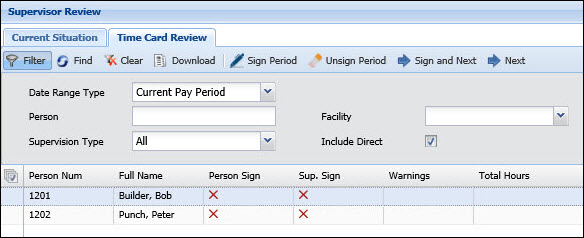
Sue needs to modify and sign Ed's timecard, so she will need a Supervision Date Policy that allows her to do that.
Sue is assigned a Supervision Date Policy that has POST and SIGN set to Supervision Dates and has VIEW set to Supervision Dates Any Day.
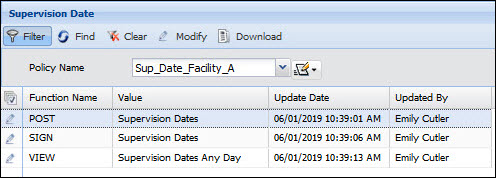
On 06/14, Sue again displays the Current Pay Period in the Time Card Review form. Now she can see Ed's timecard as well.
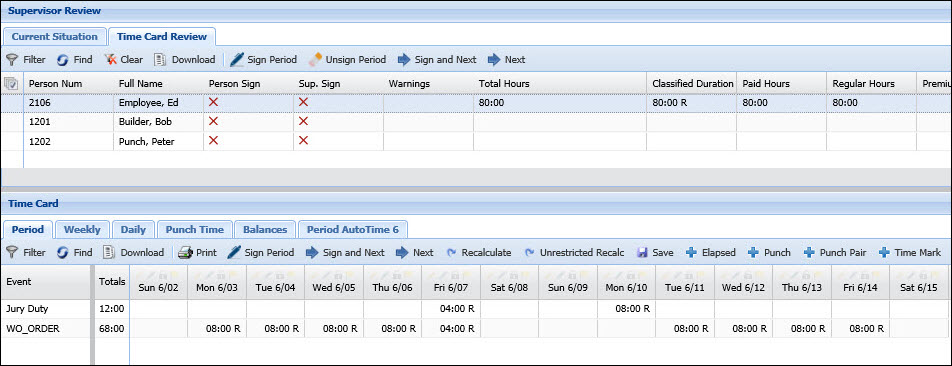
Sue wants to modify Ed's timecard on 06/07, which is a day when she was managing Ed. When she clicks the Daily tab, it opens on 06/02, which is not a day when she managed Ed. An error informs her she does not have access to this timecard.

Sue changes the date in the Daily tab to 06/07 and modifies Ed's timecard.
Sue returns to the Period tab and notices a problem with a date when she was not Ed's manager. She right-clicks the event she wants to change and selects Modify. An error appears because Sue does not have posting access on this date.
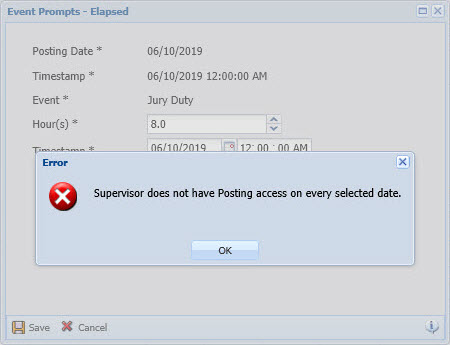
Sue is done making changes to Ed's timecard and is ready to sign it. In the Period tab, Sue clicks the Sign Period button.
A warning message informs Sue that she only has partial signing access, and only the accessible days were signed.

Sue can see that Ed's timecard is only signed on the days when she managed him.
